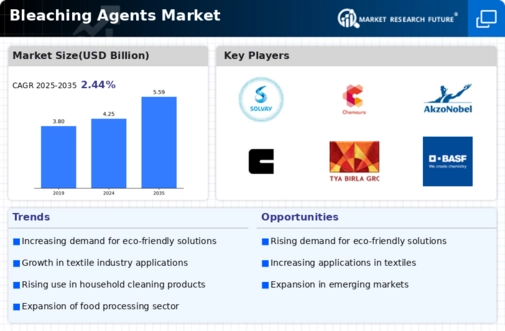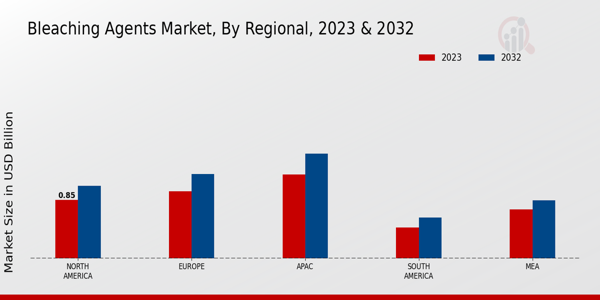Regulatory Compliance
Regulatory compliance is a significant driver in the Bleaching Agents Market, as governments worldwide are implementing stringent regulations regarding chemical usage. These regulations aim to protect human health and the environment from the adverse effects of hazardous substances. Companies are increasingly required to adhere to safety standards and environmental guidelines, which influences their choice of bleaching agents. For example, the European Union's REACH regulation mandates the registration and evaluation of chemical substances, including bleaching agents. This regulatory landscape compels manufacturers to invest in research and development to create compliant products, thereby shaping the competitive dynamics of the Bleaching Agents Market.
Sustainability Initiatives
The increasing emphasis on sustainability within the Bleaching Agents Market is driving demand for eco-friendly and biodegradable bleaching agents. Companies are actively seeking alternatives to traditional chlorine-based agents, which are often associated with environmental hazards. This shift is reflected in the growing market for hydrogen peroxide and sodium percarbonate, which are perceived as safer options. As consumers become more environmentally conscious, manufacturers are compelled to innovate and develop products that align with these values. The market for sustainable bleaching agents is projected to grow at a compound annual growth rate of approximately 5% over the next five years, indicating a robust trend towards greener solutions in the Bleaching Agents Market.
Technological Advancements
Technological advancements play a pivotal role in shaping the Bleaching Agents Market. Innovations in production processes and formulations have led to the development of more effective and efficient bleaching agents. For instance, the introduction of advanced enzymatic bleaching agents has enhanced the performance of textiles and paper products while reducing the environmental impact. Furthermore, automation and digitalization in manufacturing processes are streamlining operations, thereby reducing costs and improving product quality. The integration of smart technologies is also enabling real-time monitoring of bleaching processes, which enhances efficiency. As these technologies continue to evolve, they are likely to create new opportunities and challenges within the Bleaching Agents Market.
Consumer Awareness and Preferences
Consumer awareness and preferences are increasingly influencing the Bleaching Agents Market. As consumers become more informed about the ingredients in their products, there is a growing preference for safe and non-toxic bleaching agents. This trend is particularly evident in the household cleaning and personal care sectors, where consumers are gravitating towards products that are free from harmful chemicals. Manufacturers are responding to this shift by reformulating their products to include safer alternatives, such as oxygen-based bleaching agents. This change not only caters to consumer preferences but also aligns with broader health and safety trends. The impact of consumer awareness is likely to continue shaping the product offerings within the Bleaching Agents Market.
Rising Demand in End-User Industries
The rising demand for bleaching agents in various end-user industries is a crucial driver for the Bleaching Agents Market. Sectors such as textiles, paper, and food processing are experiencing significant growth, leading to increased consumption of bleaching agents. The textile industry, in particular, is projected to expand at a rate of 4% annually, driven by the need for high-quality, bright fabrics. Similarly, the paper industry is witnessing a resurgence, with a growing need for bleached pulp and paper products. This surge in demand from multiple sectors is likely to bolster the overall growth of the Bleaching Agents Market, as manufacturers strive to meet the evolving needs of their customers.


















Leave a Comment